A pub crawl through New Zealand history: Five long-standing pubs to visit around the country
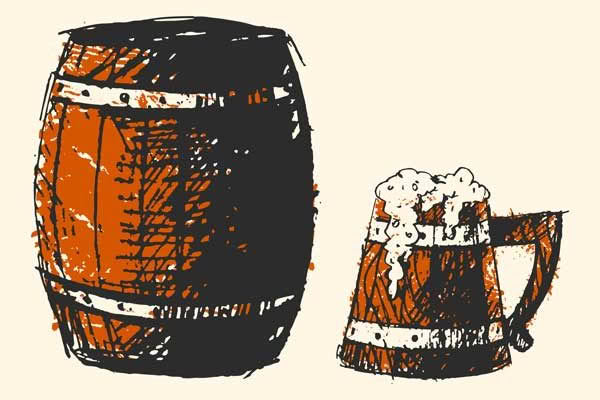
These five historical pubs have have survived the gold rush and the six o’clock swill. They are well worth a visit for those who wish to soak up some New Zealand history with a cold one in hand.
In 1894 New Zealand had 1,719 licensed premises serving a population of well under one million. A new book by Peter Janssen, New Zealand Pubs: 175 classic pubs to visit, is a guide to the best historic pubs (built before ’67 and before the six o’clock swill) still standing today.
Janssen explores how New Zealand’s drinking culture has been shaped by events such as the gold rush, an influenza epidemic, township rebellion and the building of railway lines.
And yet, the five pubs listed below look nearly the same now as they did one hundred and fifty years ago.
COROMANDEL
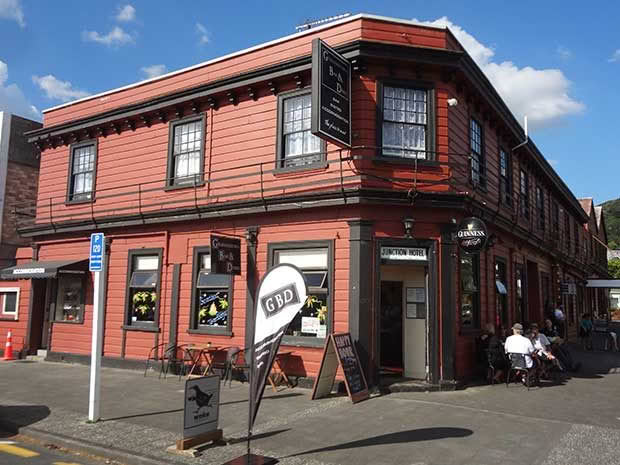
JUNCTION HOTEL
Built: 1869
When gold was discovered in Thames in August 1867, gold miners from all over the globe set sail for New Zealand. Within a short period the local population reached 11,000 people, as big as Auckland at the time. Along with the miners came the merchants, including hoteliers, and by 1872 the town boasted two breweries and 112 hotels, though many of these were mere wooden facades with the rest of the building made of canvas.
Today just three pubs remain, and the Junction is one of these. Thames at the time was two distinct settlements – Shortland to the south and Grahamstown to the north – and the junction between the two was the Karaka Stream. When a hotel was built at the junction in 1869 the choice of name was obvious.
Recently restored, the Junction today would be easily recognised by a time traveller from the gold rush days. The main bar on the corner of Pollen and Pahau Street, with its extensive use of wood, polished floors and historic photos and sketches, is both stylish and functional, and the atmosphere is warm and welcoming.
A sports bar is behind the hotel, with the main entrance off Pahau Street. On the corner, café seating catches the afternoon sun, the ideal spot to settle in for a cool drink after a busy day.
GOLD RUSH DAYS
During the gold rushes of the nineteenth century it was not unusual in New Zealand for whole towns, and especially hotels, to literally spring up overnight. On the West Coast, Ross boasted 21 hotels, Hokitika 103 (84 in Revell Street alone), and Greymouth 57. Thames on the Coromandel had 113 hotels in its heyday, and Naseby in Central Otago had 22 hotels – 10% of the population were publicans.
Many were very basic structures, some merely with a wooden façade and a canvas back. Some hotels were tiny, and in the original Stanley Hotel at McRaes Flat there was more space behind the bar than in front.
Prospectors would often arrive in town, cash up their gold at a hotel or bank and hand the money over to the publican, only leaving when their money ran out after blowing the lot on lodging, food and drink (and sometimes women). Arthur’s Point Hotel near Queenstown was both an hotel and a bank.
Food: Hearty pub meals and snacks, which are better than average, matched by a good range of beers, wines and cocktails. Open for lunch and dinner, and for breakfast on the weekend.
Accommodation: 17 renovated rooms designed to suit every budget, ranging from en suite through to dormitory beds.
700 Pollen Street, Thames
Ph: 07 868 6008
Web: www.thejunction.net.nz
TARANAKI
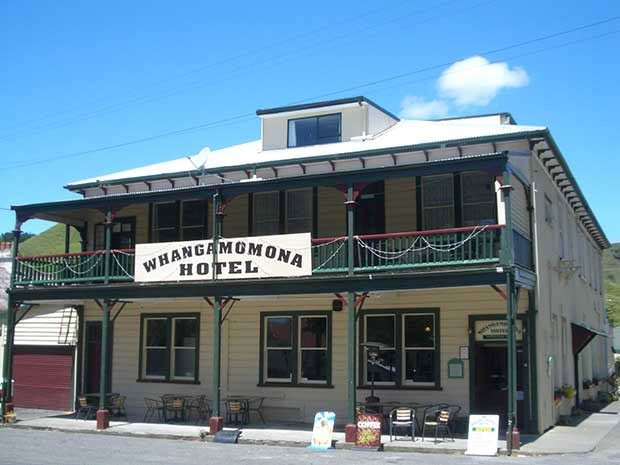
WHANGAMOMONA HOTEL
Built: 1911
Located in the heart of the Forgotten World Highway, the Whangamomona Hotel is legendary. The original hotel was built in 1902 to service both the railway between Taumaranui and Stratford and the growing farming community in the rugged Taranaki back country.
Burnt down in 1910, the replacement pub was rebuilt in 1911; though the original coal range from the old hotel, a solid Shacklock built in Dunedin, survived the fire and is still in the kitchen today. During the 1918-19 influenza epidemic, the hotel doubled as a hospital, and the old morgue is now used as a storage room.
Whangamomona shot to fame when, in 1989, the district declared independence as a protest to redrawn local government boundaries that moved half the district from Taranaki into the Manawatu.
The heart of the rebellion was the pub where the plot was hatched, and independence declared. Today the hotel still issues ‘Whangamomona Republic Passports’ and is the centre of the bi-annual (every odd numbered year) Republic Day celebrations in January, which attracts thousands to this tiny township with a population of just 15 people.
The Whangamomona Hotel today successfully achieves the ideal combination of rustic charm and modern facilities. The walls are lined with pictures of local sports teams, snapshots of local celebrities and old historic black and white photos, including the wedding photo of Mr Hodder, who built the hotel.
Meals are available both in the main bar and in the dining room and there is seating both under the veranda on the main street or in the small garden behind the pub.
Food: A good range of pub meals, lighter snacks and good coffee.
Accommodation: Simple rooms, very clean and tidy, with shared facilities and access to the marvellous veranda over the main street. Also five new, self-contained units behind the hotel. This is a popular spot and it pays to book ahead, especially for the weekends.
6018 Ohura Road/ SH 43, Whangamomona
Ph: 06 762 5823
Web: www.whangamomonahotel.co.nz
WELLINGTON
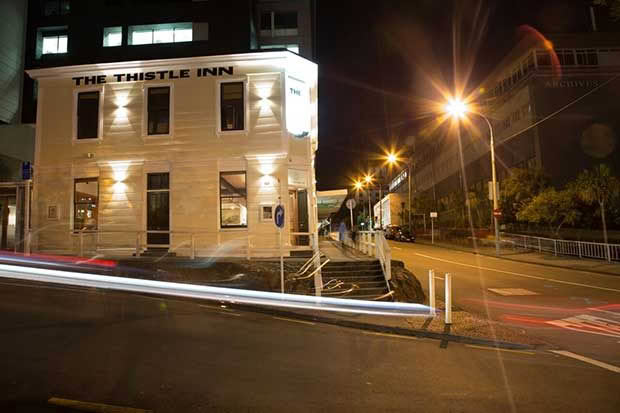
THISTLE INN
Built: 1866
Built by Scotsman Thomas Couper, who clearly named the hotel after his homeland’s national symbol, the Thistle Inn holds New Zealand’s second liquor license. The first hotel was built in 1840 on a rise above a beach and like so many wooden hotels burnt down.
Rebuilt in 1866, the Thistle externally has altered very little since, though now it is a fair way from the sea and today has modern high rise buildings as neighbours. Early patrons could arrive at the pub by water and legend has it that the famous fighting chief Te Rauparaha on occasions landed his waka on the beach below the pub for a drink at the Thistle.
A poem by Katherine Mansfield about the Thistle hangs on wall and the following quote is the opening line of her 1907 short story Leves Amore ‘I can never forget the Thistle hotel. I can never forget that strange winter night.’
Renovations have placed considerable emphasis on the historic nature of the hotel with old photos that include great snapshots of many old Wellington pubs that have long since been demolished.
Other photos show the Thistle when it was a waterfront hotel and in the foyer are the original plans of the building. A glass window has been inserted into the old wooden floors giving a peek into the old beer cellar below.
Today the pub is one single bar and dining area along with a small sheltered courtyard and can be busy at lunchtimes and just after work. Adjoining the old hotel is an extension containing the hotel’s elegant restaurant.
The atmosphere is warm and friendly, with a good selection of New Zealand beers on tap and excellent food.
Food: Lunch and dinner. Definitely gastro pub food, with prices to match.
3 Mulgrave Street, Wellington
Ph: 04 499 5980
Web: www.thistleinn.co.nz
CANTERBURY
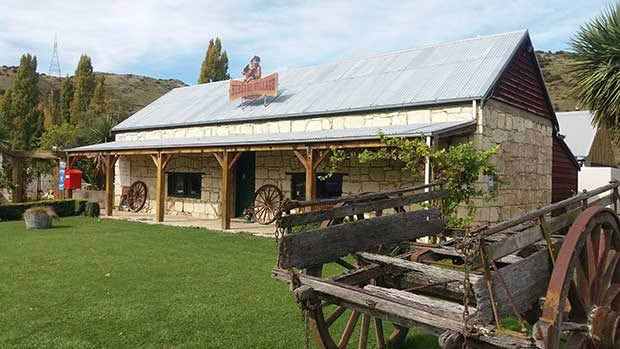
HISTORIC HURUNUI HOTEL
Built: 1860/1868
On the inland route between Christchurch and Kaikoura, the original hotel was built by John Hastie in 1860 on a site near the Hurunui River, and it holds one of the oldest licenses in Canterbury. Named the Hurunui Accommodation House, it was better known as ‘Hasties’.
The conditions of the license required Mr Hastie to provide eight beds in four rooms, with shelter for up to six horses, stockyards for cattle and fresh horses for those wanting to cross the river, and that he must direct them to the safest point to do so.
The hotel served as a central meeting point and run holders would travel from miles around to collect mail and news. Drovers from Nelson would stop here and dip their sheep before crossing the Hurunui River, to prevent scabs from being carried into Canterbury.
After a massive flood hit the region, Hastie’s widow decided to move the hotel to higher ground, even though the flood had not directly threatened the hotel. Constructed of limestone blocks quarried from nearby Weka Pass, in 1868 the entire hotel was dismantled and rebuilt on the present site.
In the 1940s the owner, James O’Connell, renamed the hotel O’Connell’s Hurunui Hotel. Sadly, as time passed the hotel fell into disrepair, but in 1979 around 100 local shareholders rallied together, and with the help of the Historic Places Trust they were able to return it to its former status. Badly damaged by the 7.8 Kaikoura earthquake in 2016, it took almost two years for the hotel to reopen, in time for its 150th anniversary.
Today the two-storey hotel retains an exterior and interior that reflect a typical nineteenth century hotel. Simple in design, the hotel has a fine façade complemented by a veranda that runs the length of the hotel. Like many hotels of the period, it put its best face forward; the front built with finely dressed stone while the rest of the building is constructed of more basic shaped blocks.
Most older hotels have opened up the maze of rooms on the ground floor to form one large bar/dining room, but the Hurunui still retains most of the original floor plan. The main bar just inside the main door is tiny, off which two rooms led to the left and right.
Today both are extensions of the bar, but originally they would have been sitting rooms or a ladies bar, each complete with an open fireplace. Beyond, at the back of the hotel, is the dining room.
Two garden bars flank the hotel, the one to the left a beer garden and the other a wine garden. The pub runs a small vineyard behind the hotel, producing wine under the Hurunui Village label.
Beyond that wine garden are the stables, which by the year 2000 were in ruin. When the talk turned to restoration, locals returned three truckloads of blocks that had been taken from the stables and used on farms. Behind the stables is the old blacksmith’s shed.
And what is an old hotel without a ghost? In this case Charlotte, a maid in the hotel who mysteriously disappeared in the 1890s. One of New Zealand’s most iconic hotels, the Hurunui is well worth the short trip off State Highway 1.
BARMAIDS BANNED
In previous generations, the pub was never considered a suitable place for respectable women. Many early hotels had a separate ‘Ladies Bar’, strictly for women only, and more often than not these small bars had their own entrance from the street, with no internal access to the main bar
Food: Country style food with a reputation for generous portions.
Accommodation: Seven rooms upstairs, with shared facilities, plus two five star cottages behind the vineyard.
1224 Karaka Road/SH 7, Hurunui
Ph: 03 314 4207
Web: www.wwwhurunuihotel.co.nz
CENTRAL OTAGO

THE CARDRONA HOTEL
Built:1863
The Cardrona Hotel is legendary, and claims that it is the most photographed hotel in New Zealand are not exaggerated. Almost an architectural style in its own right, the hotel, simple in style, is an excellent example of the small wooden hotels that blossomed virtually overnight to service the burgeoning population on the goldfields.
Situated in the Cardrona Valley between Queenstown and Wanaka, the township in its heyday had at least four hotels. While the fortunes of the town have waned and the population has drifted away, the Cardrona Hotel survives, but only just.
Jim Patterson is without a doubt the hotel’s most colourful publican. Jim initially worked a gold claim in the valley before taking over the hotel in 1926, and he ran the pub until his death in 1961 at the age of 91. Jim was eccentric to say the least.
He refused to serve women and Jim, not the customer, decided how much they could drink. If you were travelling in the direction of Queenstown over the Crown Range, then one drink was the limit, but if you were going towards Wanaka then you could have two drinks.
His signs strung out along the road were famous, and one still exists by the front door to the hotel: ‘If you have a Shilling Stop, if not Step on it.’ The old, narrow bar that Jim presided over is still in the hotel and his benign ghost is said to linger at the hotel. After Jim’s death the hotel closed and was finally saved from dereliction, first reopening as a restaurant in 1983 and with accommodation added in 2002.
What makes the Cardrona so appealing is that while it has all the facilities of a modern hotel, it has successfully preserved the most attractive features of the historic pub. It is much bigger than the narrow wooden frontage suggests, but it manages to keep that warm friendly ambience that only an old building can impart. Behind the hotel the large garden is a real surprise. In summer the garden is shady and colourful with flowers, while in winter it is warmed by an outdoor fireplace and braziers.
Next door, the old school house has been developed into a gift shop, and outside the hotel is a vintage Chrysler that adds to the hotel’s photogenic appeal.
Cardrona Valley Road, Cardrona
Ph: 03 443 8153
Web: www.cardronahotel.co.nz
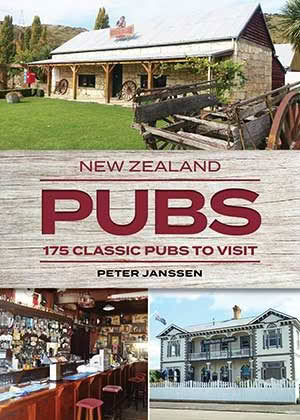
New Zealand Pubs: 175 classic pubs to visit by Peter Janssen
Extract reproduced with permission from New Holland Publishers New Zealand
RRP$29.99
READ MORE
Exploring the Forgotten World Highway’s Stratford-Okahukura railway line
Driving through the Forgotten World Highway in the new Holden Equinox SUV

